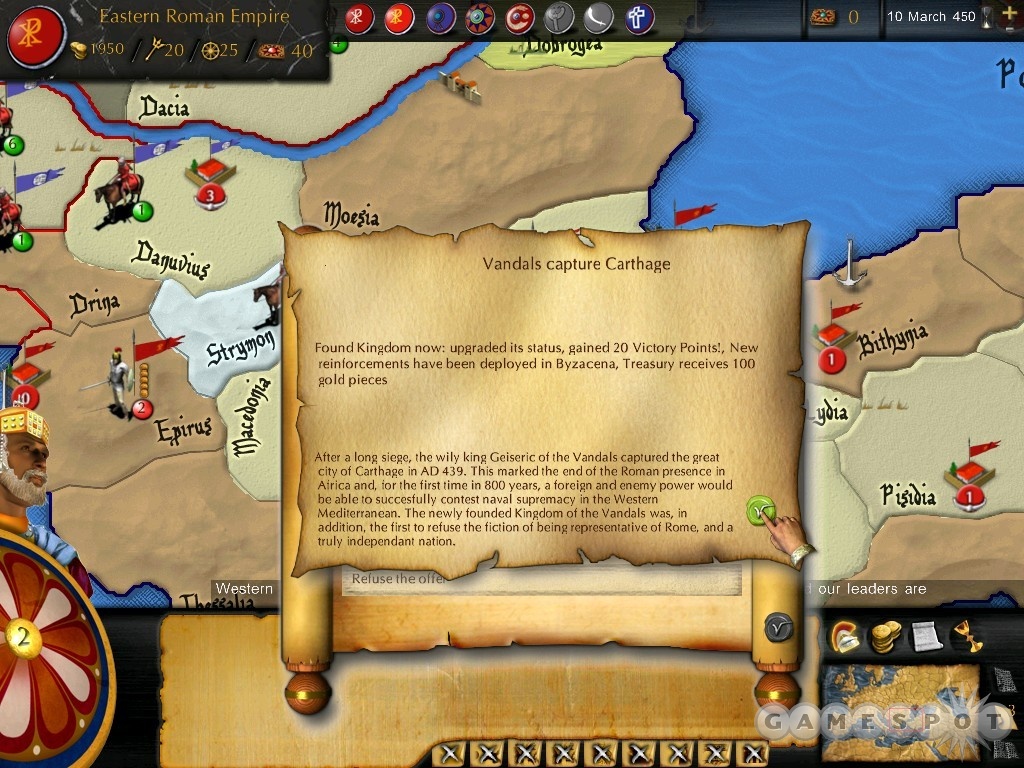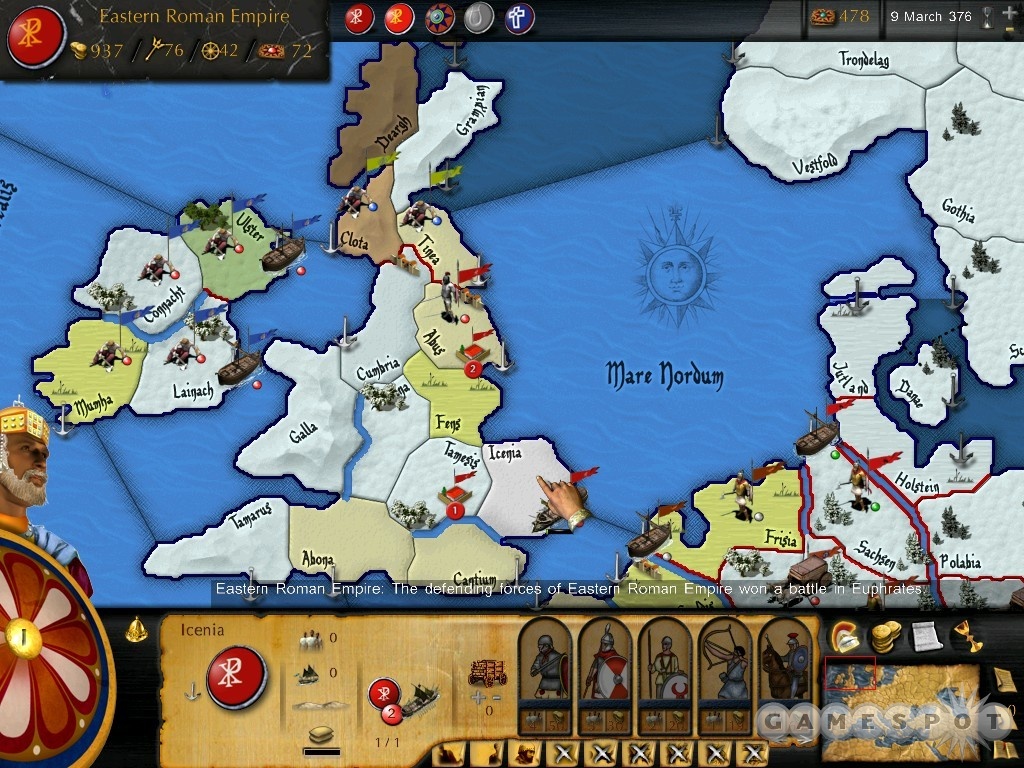Adjust your expectations significantly downward and you might be able to wring some enjoyment out of Great Invasions: The Dark Ages 350-1066 AD. This real-time strategy game from French developer Indie Games Productions (originally released in Europe in 2005) may be a second-stringer in comparison with the Europa Universalis franchise that it mimics, but this intricate epic piles on the details for historical gamers who want more of a textbook feel than that offered by the likes of EU III. Just expect to spend a lot of time figuring this one out, as some odd design decisions, along with interface and documentation shortcomings, make it one of the most complicated strategy games you'll ever play.

Considering the game's lineage, its complex personality isn't a surprise. Great Invasions is the product of Philippe Thibault, who crafted the original cardboard edition of Europa Universalis and helped developer Paradox Interactive first adapt that game to the PC. This new effort is similar in tone to that predecessor, although it lacks the peculiar charm of the Paradox title while retaining the foibles that have made the EU series such an acquired taste. The biggest problem here is terrible documentation of the game's tremendous scope. Even though the subject matter spans over 700 of the most tumultuous years in European history and includes six campaigns ranging from a grand campaign to involved historical scenarios like Justinian's attempt to reconquer the Roman West in the 500s and the mayhem of the mid-fourth century during the reign of Constantius II, the two brief tutorials are worthless and the manual is a mere 24-page pamphlet. You need more of a leg up than that, especially given your ability to run multistate medieval empires that encompass more than 80 states and a couple dozen ethnic groups.
As with EU and other daunting Paradox games like Victoria and Crusader Kings, you'll need to get days, if not weeks, of play under your belt before you understand what's going on. And as with EU and its ilk, the interface is woefully inadequate. A blizzard of pop-ups assail the screen from the moment you start playing, demanding your decision on such matters as waging war on Persia or supporting an allied power's war on a third party, or just simply recognizing that the Huns are pushing the Alans west and barbarians will soon be invading your territory (the game definitely deserves its name). Many of the most important questions that you're presented with show up right at the very start of campaigns, and they arrive without any historical background giving you the information needed to say "yea" or "nay" with confidence. A wrong call at this stage can ruin whole games, as we found out when we foolishly allowed a vassal state to draw the Eastern Roman Empire into a full-blown war with Sassanid Persia at the beginning of a sixth-century campaign. Restart or say goodbye to that dream of holding on to Northern Africa and Italy, Justinian.
Even worse, Great Invasions adds a whole new level of complication by forcing you to control numerous quasi-independent states instead of single powers. So rather than choosing, say, the Western Roman Empire or Persia or the Huns or whatever, you start a campaign by selecting the red, blue, green, or yellow team, which includes a range of allied nations and groups. In the 375 campaign, for example, the red group includes both halves of the Roman Empire, the Franks, the Irish principalities, and the Catholic Church, while the blues feature Western barbarians like the Goths and Picts; the greens, Northern tribes like the Saxons and Angles; and the yellows, Eastern powers like Persia and the Huns. This adds an enormous amount of confusion to gameplay, as you have to make independent decisions for all of these states and factions. For instance, you could start a war between your Eastern Roman Empire and Persia but maintain relatively cordial relations between your Western Roman Empire and those same Persians.
As you might expect, this provides for some fascinating strategic options--although all of the possible permutations will make your head spin. In the end, it feels too much like you're involved in two or three games simultaneously, never getting the time to play any one of them properly. Just when you get things sorted out with the Saxons in Britain, there's a revolt against the Eastern Romans in Egypt or Alamanni trade demands arising in the West. You also never get to focus on a single aspect of the game itself, as the focus is spread too thin among straight-out imperial conquering and more esoteric concerns such as the battles between different Christian philosophies. This is good in some ways, because it allows for a fascinating historical overview of the political and religious turmoil that marked late antiquity and the early medieval era. But it's mostly just frustrating because it's hard to care about a Monophysite revolt in Judea when you're dealing with an incursion of Huns, or vice versa, and the pop-up-reliant interface makes you rush from one hot spot to another, never taking the time to really get a handle on any one crisis.
Other aspects of the game don't mitigate the complexity. There are three settings to govern how the solo campaigns play out, but all have flaws. The default historical preset option provides the most history-book flavor, but it's so close to what really happened that you can cheat if you have any awareness of dates or one of those "This Day in History" books covering the time period open on your desk. The other two options--historical open and fantasia--loosen things up somewhat, although they both sacrifice some of the historical authenticity. Multiplayer is also available, but you need to know the IP address of your opponent because there's no matching server to facilitate finding games.

Presentation values themselves just may date back to the Norman conquest of England. The game doesn't require much more than a map and a few menu screens, although they are all of sub-EU quality. Resolution is fixed at 1024x768, and the scrolling is incredibly twitchy and can't be adjusted. Typos and grammatical errors, presumably introduced when translating the original game's French into English, are everywhere. They range from relatively harmless misspellings like "Wisigoth" to nonsensical paragraphs that defy decryption. Audio is pretty much nonexistent, save for an overly bombastic score that sounds like something you'd expect from a hack-and-slash RPG.
As with so many historical strategy games, how much you get out of Great Invasions depends on how much effort you're willing to put into playing it. There is a great amount of detail here dealing with one of the most unexamined periods in medieval history, but Indie Games really needed to put more effort into making the whole shebang easier to understand and play. This isn't a bad game by any stretch of the imagination--although it's hard to think of a less friendly one.